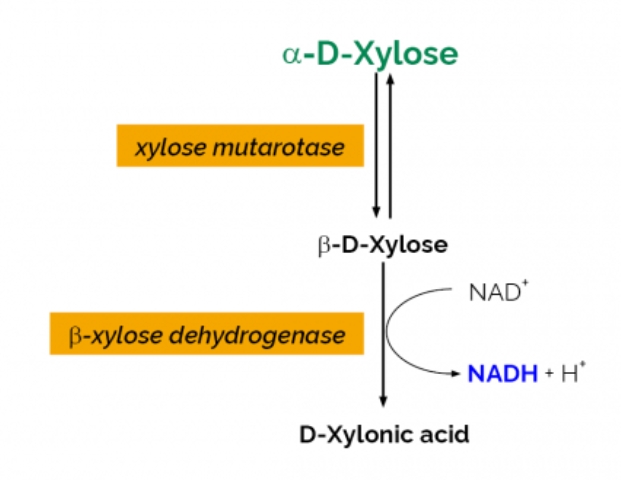- 背景資料
植物的細胞壁主要由纖維素、半纖維素、木質素、果膠所組成,纖維素為葡萄糖以β(1→4)醣苷鍵鍵結而成的多醣,木質素主要為多酚類物質所構成。而半纖維素則是泛指在植物細胞壁當中,非纖維素、非果膠之多醣類,其成分主要以木聚醣(Xylan)為主。
木聚醣(聚木醣)(Xylan)主要是由木糖(Xylose)以β(1→4)醣苷鍵鍵結而成之異質性多醣(Heteropolysaccharides),主鏈是由木糖所組成,其側鏈(C2、C3位置)常會由不同的取代基1所構成,其中阿拉伯木聚醣(Arabinoxylan)2是最為常見的種類之一。
➡️備註1:取代基的種類眾多,例如:葡(萄)糖醛酸(Glucuronic acid)、阿拉伯糖(L-Arabinose)、阿魏酸(Ferulic acid)、香豆酸(p-Coumaric acid)...等
➡️備註2:阿拉伯木聚醣(Arabinoxylan),支鏈為阿拉伯糖,主鏈為木聚醣,為穀物半纖維素的主要組成。
- A. MANUAL ASSAY PROCEDURE:

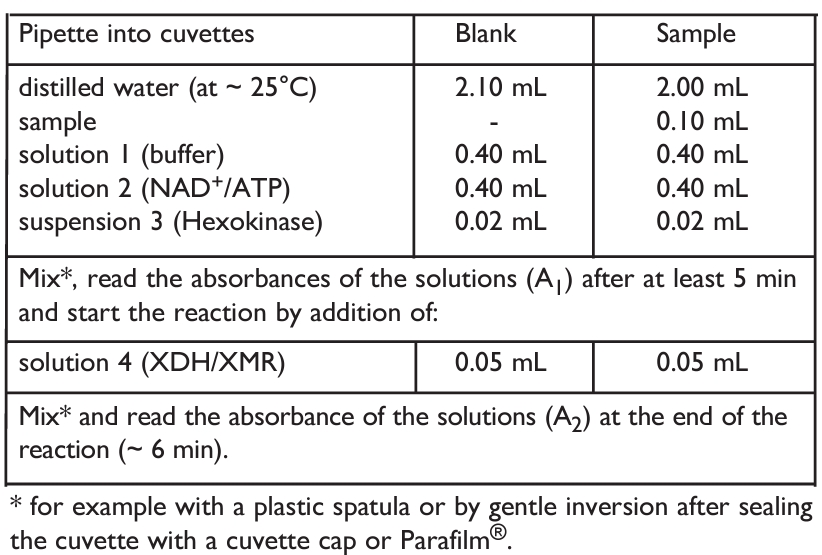
- B. AUTO-ANALYSER ASSAY PROCEDURE:
NOTES:
1. The Auto-Analyser Assay Procedure for D-xylose can be performed using either a single point standard or a full calibration curve.
2. For each batch of samples that is applied to the determination of D-xylose either a single point standard or a calibration curve must be performed concurrently using the same batch of reagents.
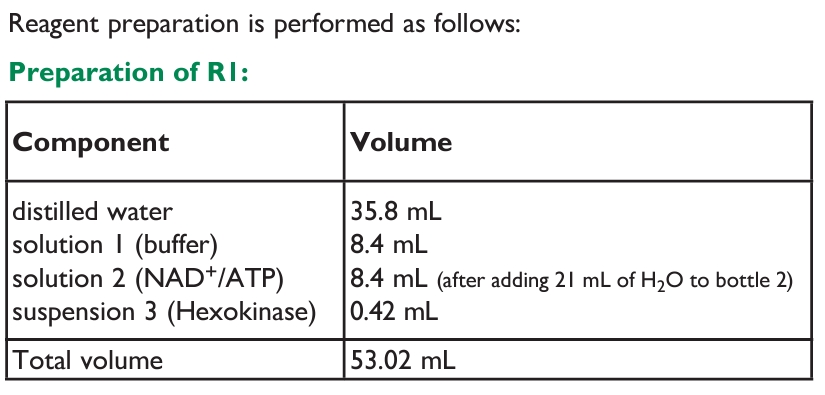
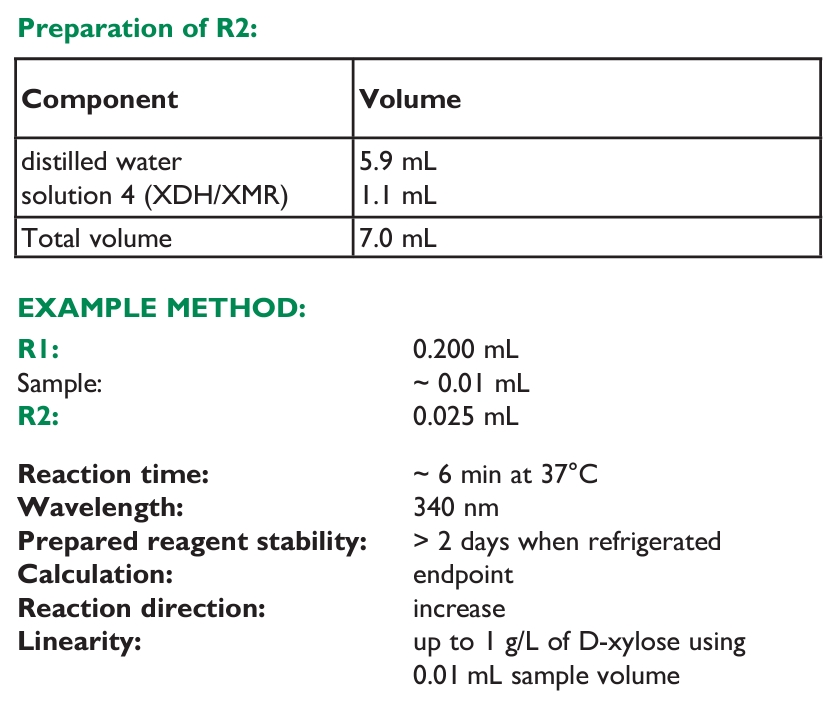
- C. MICROPLATE ASSAY PROCEDURE:
NOTES:
1. The Microplate Assay Procedure for D-xylose can be performed using either a single point standard or a full calibration curve.
2. For each batch of samples that is applied to the determination of D-xylose either a single point standard or a calibration curve must be performed concurrently using the same batch of reagents.

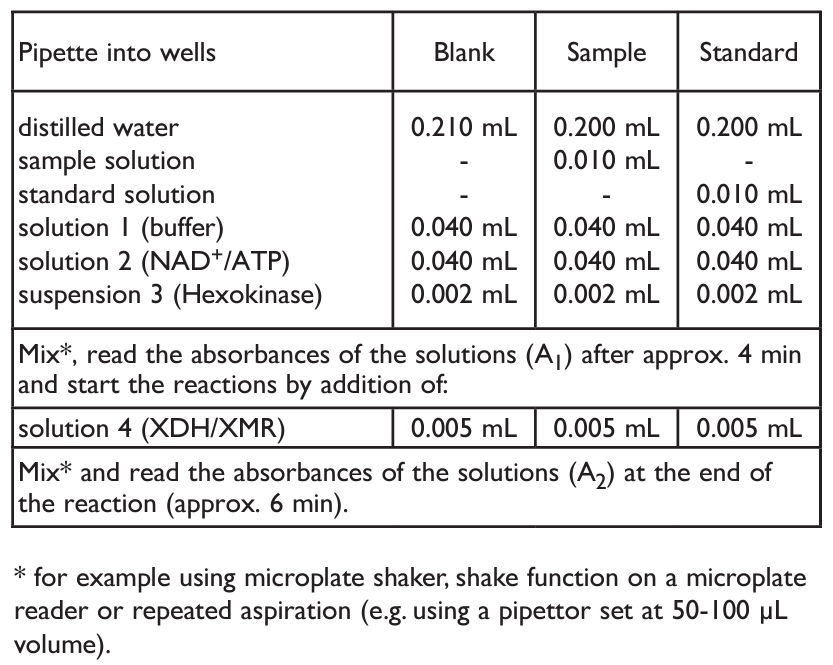
- SAMPLE PREPARATION:
1. Sample dilution.
The amount of D-xylose present in the cuvette (i.e. in the 0.1 mL of sample being analysed) should range between 2 and 100 μg. The sample solution must therefore be diluted sufficiently to yield a D-xylose concentration between 0.002 and 1.00 g/L.
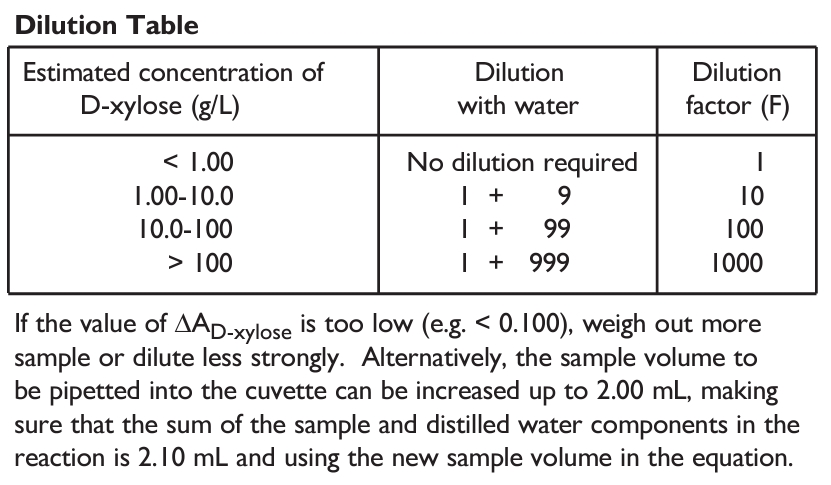
2. Sample clarification.
a. Solutions:
Carrez I solution. Dissolve 3.60 g of potassium hexacyanoferrate (II) {K4[Fe(CN)6].3H2O} (Sigma cat. no. P9387) in 100 mL of distilled water. Store at room temperature.
Carrez II solution. Dissolve 7.20 g of zinc sulphate (ZnSO4.7H2O) (Sigma cat. no. Z4750) in 100 mL of distilled water. Store at room temperature.
Sodium hydroxide (NaOH, 100 mM). Dissolve 4 g of NaOH in 1 L of distilled water. Store at room temperature.
b. Procedure:
Pipette the liquid sample into a 100 mL volumetric flask which contains approx. 60 mL of distilled water, or weigh sufficient quantity of the sample into a 100 mL volumetric flask and add 60 mL of distilled water. Carefully add 5 mL of Carrez I solution, 5 mL of Carrez II solution and 10 mL of NaOH solution (100 mM). Mix after each addition. Fill the volumetric flask to the mark, mix and filter.
3. General considerations.
(a) Liquid samples: clear, slightly coloured and approximately neutral, liquid samples can be used directly in the assay.
(b) Acidic samples: if > 0.1 mL of an acidic sample is to be used undiluted (such as wine or fruit juice), the pH of the solution should be increased to approx. 7.5 using 2 M NaOH, and the solution incubated at room temperature for 30 min.
(c) Carbon dioxide: samples containing a significant amount of carbon dioxide should be degassed by increasing the pH to approx. 7.5 with 2 M NaOH and gentle stirring, or by stirring with a glass rod.
(d) Coloured samples: an additional sample blank, i.e. sample with no β-XDH, may be necessary in the case of coloured samples.
(e) Strongly coloured samples: if used undiluted, strongly coloured samples should be treated by the addition of 0.2 g of polyvinylpyrrolidone (PVPP)/10 mL of sample. Shake the tube vigorously for 5 min and then filter through Whatman No. 1 filter paper.
(f) Solid samples: homogenise or crush solid samples in distilled water and filter if necessary.
(g) Samples containing fat: extract such samples with hot water at a temperature above the melting point of the fat, e.g. in a 100 mL volumetric flask. Adjust to room temperature and fill the volumetric flask to the mark with distilled water. Store on ice or in a refrigerator for 15-30 min and then filter. Discard the first few mL of filtrate and use the clear supernatant (which may be slightly opalescent) for assay. Alternatively, clarify with Carrez reagents.
(h) Samples containing protein: deproteinise samples containing protein with Carrez reagents.
商品特色
商品規格
- 商品規格
100 assays (manual) / 1000 assays (microplate) / 1300 assays (auto-analyser)
Bottle 1:
Buffer (45 mL, pH 7.5) plus sodium azide (0.02% w/v) as a preservative.
Stable for > 2 years at 4°C.
Bottle 2: *2
NAD+ plus ATP. Freeze dried powder.
Stable for > 5 years below -10°C.
Bottle 3:
Hexokinase suspension (2.2 mL).
Stable for > 2 years at 4°C.
Bottle 4:
XDH/XMR solution (5.6 mL).
Stable for > 2 years below -10°C.
Bottle 5:
D-Xylose standard solution (5 mL, 0.25 mg/mL).
Stable for > 2 years; store sealed at 4°C.
